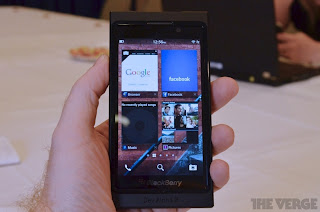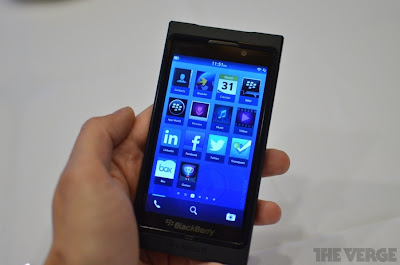Blackberry 10 Unveiled
Last month, RIM unveiled the BlackBerry 10 beta 3 running on the company's
new test device, the Dev Alpha
B. The UI look and feel of this latest BlackBerry 10 build is
what RIM will be putting on its final BB10 devices in early 2013. The most
fundamental difference of BB10 from previous builds is not just the presence of
touch navigation, but a complete focus on it. RIM is clearly aiming to take
Android’s crown for best multitasking and the entire interface is based around
the premise of being able to get to any app-based information you want at any
point. |
| Active Frames |
However, it is not really a home screen in the sense that it holds widgets and app shortcuts. Rather, it houses what RIM calls "Active Frames". These are functionally similar to Windows Phone's Live Tiles or Android home screen widgets, but rather than being separate entities they are actually minimized versions of currently running applications. The frames can show either a thumbnail view of the entire app, or a special view of the application designed for the home screen. Because these apps are all currently loaded into memory, switching back to them is quick and seamless. Swiping right of the Acitve Frames, reveals the classic list of App icons. They can be manually moved around and sorted to your liking
As RIM chief executive Thorsten Heins put it: ‘Nobody should have to worry about opening apps’.
Heins made plenty of emphasis about the fact that, on other platforms there’s typically a lot of what he described as ‘in and out’ of various applications. RIM wants to avoid that with BB10 and this is achieved through two key components.
 | |
| Hub |
In a sense it’s rather a lot like Windows Phone’s People Hub, a feature we enjoyed immensely.
From here you can search, filter and compose messages from all the apps you have feeding the hub with message notifications. It’s also worth noting that you have complete control over exactly which apps and accounts contribute to the feed. It's accessible by a new gesture - swipe up and to the right. Once you access it, you can see your notifications alongside the aforementioned emails and messages.
The second component is BlackBerry Flow, which is essentially the touch-based control mechanics you use to access various parts of the interface, including the ever-present BlackBerry Hub.
RIM has implemented a control gesture which, from any part of the phone, allows you to swipe up to minimize your currently active app, home screen, or whatever, and see a list of how many notifications you have along the left-hand side of the screen.
The navigation in BlackBerry 10 is heavily gesture-based, beginning with the lock screen: unlocking the phone is done by swiping up from the bottom of the screen, but you don't have to press a button to bring up the lock screen first. Swiping up from the bottom of the screen also switches from the app you're currently using back to the home screen. Swiping up and then dragging your finger to the right exposes the so-called BlackBerry Hub, a messaging app that corrals all of your mail, texts, tweets, calls, and other messages into one place.
In-app navigation is also gesture-heavy: if, for example, you're in an e-mail app and you open an attachment, you can swipe to the right to hide the attachment and see the original e-mail, then swipe again to see your inbox. Swiping up slightly, holding your finger where it is, and then swiping back down will allow you to take a peek at notifications and then go back to using your app. RIM calls this the ‘BlackBerry Peek’.
RIM has integrated an interesting feature allowing you to switch the device into personal or work mode when you swipe down from top of the screen when viewing the App icons screens. Choosing Work mode allows you to launch an app in a secure mode. You can seamlessly switch between the two modes, but you’ll have access to completely separate apps, App Worlds storefronts, email accounts, connectivity settings and so on.
Another intriguing feature is in the camera app, meant to compensate for people who aren't good at timing photos. If users time a photo incorrectly, they are able to page backward in time on the camera to an earlier version of the photo, as if the camera was taking shots continuously before the shutter button was actually pressed.
Judging from the what we’ve seen, the latest build of BlackBerry 10 looks very promising. It's very fast and fluid, and packs a lot of interesting UI features that its competitors currently lack.
As for the new device, it features a 4.2-inch display with RIM's standardized resolution of 1280 x 768 pixels.
What do you think about what you’ve seen so far?
Listing image by The Verge





